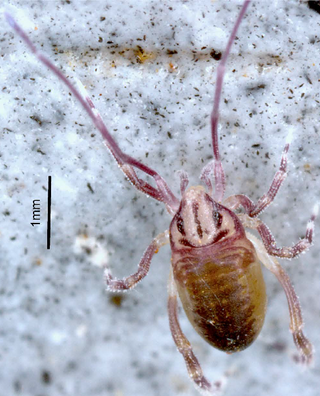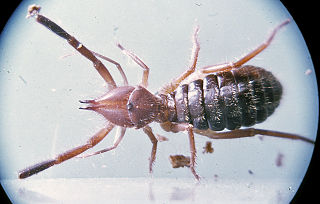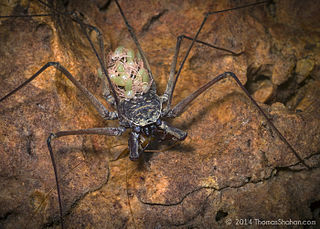
Eremobates is a genus of arachnids of the order Solifugae. About 2 inches long, these fast-moving arachnids have the largest jaw size to body ratio of any animal. They are not venomous, but have a remarkably powerful bite. Often hunting at night, they have poor eyesight and navigate mostly by use of a pair of pedipalps.

Solifugae is an order of animals in the class Arachnida known variously as camel spiders, wind scorpions, sun spiders, or solifuges. The order includes more than 1,000 described species in about 147 genera. Despite the common names, they are neither true scorpions, nor true spiders. Most species of Solifugae live in dry climates and feed opportunistically on ground-dwelling arthropods and other small animals. The largest species grow to a length of 12–15 cm (5–6 in), including legs. A number of urban legends exaggerate the size and speed of the Solifugae, and their potential danger to humans, which is negligible.

Ammotrechidae is a family of solifuges distributed in the Americas and the Caribbean Islands. It includes 26 described genera and 95 species. Members of this family can be distinguished from members of other families by the absence of claws on tarsi of leg I, tarsal segmentation 1-2-2-(2-4), pedipalps with pairs of lateroventral spines, and by males having an immovable flagellum on the mesal face of each chelicerum. The propeltidium of the Ammotrechidae is recurved.

Opilioacaridae is the sole family of mites in the order Opilioacarida, made up of about 13 genera. The mites of this family are rare, large mites, and are widely considered primitive, as they retain six pairs of eyes, and abdominal segmentation. They have historically been considered separate from other mites belonging to Acariformes and Parasitiformes, but are now generally considered a subgroup of Parasitiformes based on molecular phylogenetics.

Galeodes is a genus of solifuges or sun spiders. The nearly 200 species in this genus are found in northern Africa, southeastern Europe and Asia. Like other solifuges, they are mainly nocturnal and found in arid habitats. They often have long hairy appendages and are not as stout bodied or dark and contrastingly coloured as some other solifuges. Some Galeodes species are able to produce sounds by stridulation. These are usually raspy or hiss-like and may be imitations of the sounds of vipers, to serve a defensive function. As in other solifuges, mating involves the male depositing a spermatogonia that is manipulated into the female genital opening using their chelicera. The male strokes the female using the palps allowing her to be approached. Females will often feed on males before or after mating. The female then deposits the eggs in a burrow in soil and in some species guards them.

Daesiidae is a family of solifugids, which are widespread in Africa and the Middle East. Members of the family are also present in India, Italy, South America, the Balkans, and the single species Gluvia dorsalis in the Iberian Peninsula. A single fossil species is known from Eocene Baltic amber.

Eremobatidae is a family of solifuges, first described by Karl Kraepelin in 1901.

Chelypus ('clawfoot') is a genus of slow-moving, burrowing sunspiders confined to the deserts and arid regions of Southern Africa.

Galeodidae is a family of solifuges, first described by Carl Jakob Sundevall in 1833.

Phrynidae is a family of amblypygid arachnida arthropods also known as whip spiders and tailless whip scorpions. Phrynidae species are found in tropical and subtropical regions in North and South America. Some species are subterranean; all are nocturnal. At least some species of Phrynidae hold territories that they defend from other individuals.
Chanbria is a genus of camel spiders. It consists of four species found in the Sonoran Desert in Mexico and the southwestern United States.
Prokoeneniidae is a family of microscorpions in the order Palpigradi. There are at least two genera and about seven described species in Prokoeneniidae.
Horribates bantai is a species of windscorpion in the family Eremobatidae.
Horribates is a genus of Eremobatid camel spiders, first described by Martin Hammond Muma in 1962.

Hemerotrecha is a genus of Eremobatid camel spiders, first described by Nathan Banks in 1903.
Phrynichus is a genus of tailless whipscorpions in the family Phrynichidae. There are about 16 described species in Phrynichus.
Ceromidae is a family of solifuges, first described by Carl Friedrich Roewer in 1933.
Oltacola is a genus of ammotrechid camel spiders, first described by Carl Friedrich Roewer in 1934.
Antillotrecha is a genus of ammotrechid camel spiders, first described by Luis de Armas in 1994.
Solpugema is a genus of solpugid camel spiders, first described by Carl Friedrich Roewer in 1933.










